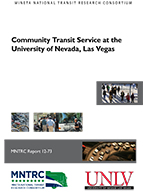Abstract:
Walking has sound health benefits and can be a pleasurable experience requiring neither fuel, fare, license, nor registration. Society also benefits by the associated reduction of motorized vehicle travel. The objective of this study was to quantify the walking environment by developing a comprehensive walkability index that (1) reflects resident perceptions of their neighborhoods’ walking environment; (2) reflects the suitability and adequacy of the pedestrian facilities in the neighborhood infrastructure and built environment, and (3) incorporates a pedestrian crash index, which measures the pedestrian crash experience.
Eleven neighborhoods in the Las Vegas, NV, metropolitan area were selected as a case study for this research. The study methodology involved surveying a sample of neighborhood residents to document perceptions of their walking environment, conducting field audits of the neighborhood infrastructure and land use related to walking, and collection of pedestrian crash data to develop crash indices to be incorporated into the walkability index.
Using survey results, cross-classification tables were developed to identify infrastructure, land use and other neighborhood features that influence walking. Statistical models were also calibrated to determine relationships between residents’ walking frequency and some key infrastructure and neighborhood features. Furthermore, the data was used to develop comprehensive walkability indices and identify features that may need improvement in order to encourage more walking.
Authors:
MOHAMED KASEKO, PH.D.
Dr. Mohamed Kaseko is an Associate Professor of Civil Engineering at the University of Nevada Las Vegas (UNLV). He holds a PhD degree from the University of California, Irvine and an MS degree from Cornell University. Dr. Kaseko’s major areas of research are in Traffic Operations and Safety, Transit and Multimodal Transportation, and Intelligent Transportation Systems. His other interests include Railway Transportation, Engineering Economics and Operations Research applications in Traffic and Transportation Operations. He has published several articles in technical journals and conference proceedings.
PERIS NYAGAH, PH.D.
Peris Nyagah is a recent PhD graduate in Civil Engineering at the University of Nevada Las Vegas (UNLV). Her research interests are in traffic engineering, transit planning, pedestrian planning and safety studies. She has a BSc IT from Jomo Kenyatta University of Agriculture and Technology, in Kenya, and an MS degree in Transportation from UNLV.


